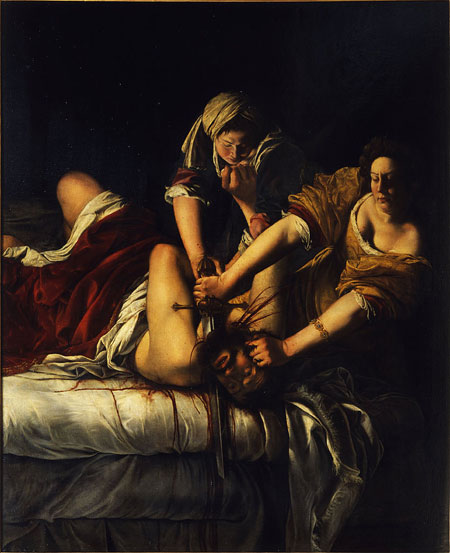Aritha Samad
February 7, 2017
W O M E N S ' R O L E S
Judith Leyster, A Woman Sewing by Candlelight (1633)
By the subject's surroundings, she appears to be indoors.
However by her facial expression, she seems to wish she
were outdoors.
|
Throughout art history, women have been discredited for their published work, limited to their means of education, and ridiculed for being in the skin of their god given gender. In general, the roles of genders tends to be a sensitive topic where fiery debates may suddenly spark and quickly boil one's blood. Typically, the argument revolves around which gender should be public and which gender should be private. Majority rules men are to own, go and see, while women are to remain inside, domestic and homebound. However, I strongly believe rules and roles can be broken. From the Middle Ages, to the Renaissance, and into the 19th century, women were challenged religiously, educationally, and emotionally. But in the end, women broke the rules with their works and redefined their roles with their personal stories.
T H E M I D D L E A G E S
The Middle Ages is recognized as a period from approximately the fifth century to the fifteenth century in Western Europe of religious changes. The role of artists were to engage in heavily in crafting religious objects, sewing tapestries and working in guilds. As far as the role of women, The Roman Catholic Church set the guidelines from their core beliefs and decided on their direction. Scholars whom studied gender roles during the Middle Ages uncovered significant differences in men's and women's right. Research conduct stated differences in their right to "possess and inherit property, duties to pay homage and taxes, and civil and legal rights" (Chadwick, 44). In terms of romance, a woman's choice was nearly nonexistent. Traditionally, women were to be engaged by 12 and married by 15. Furthermore, a woman was highly encouraged to remain loyal to her husband (unless she wanted to risk being buried alive). Lastly, a woman's education was viewed as "an interference with a her ability to be a good wife and mother" (Guerrilla Girls, 22). It is important to also note during this time no women was taught to read or write. Sometimes, illiteracy meant many female artists would dismiss the signing of their works. All in all, Middle Age women were committed to the forces of the Church, their privileged husbands and their miserable households.
T H E R E N A I S S A N C E
The Renaissance is classified as the era from approximately the fourteenth to seventeenth century in Europe of intellectual and economic changes. During this era, the role of artists shifted from craftsmanship to paintings and sculptures. The Renaissance men were fortunate enough to receive money and obtain power, but they were still silly enough to believe world was flat. As far as the role of women, mercantilism allowed poor women were given a chance to rise to the selling class. Alongside the chance to become financially stable, The Guerrilla Girls published a limited list of other things Renaissance women were allowed to do. The short list stated women could also "divorce her husband only if she could him impotent and salvage her reputation by marrying any man who raped her" (Guerrilla Girls, 32). Teenage prodigy and woman artist, Artemesia Gentileschi used the rape trial of Agostino Tassi to later paint one her most famous works. Unlike the Middle Ages, Renaissance women were able expand their education horizons if they relocated to Bologna. They were also able to challenge their intelligence through learning from inside the family or joining the church. In conclusion, Renaissance women were progressing in terms of their gruesome style and flourishing education.
T H E 1 9 T H C E N T U R Y
| Elizabeth Thompson, Calling the Roll After an Engagement (1874) Muchlike Rose Bonheur, Thompson took on (and nailed) subjects such as war and soldiers which society claims belong to men. |
The 19th century is portrayed as the period in the U.S. of political changes. The role of artists swayed from self portrait paintings to emotional paintings. As far as the role of women, 19th century women experienced great technological advances which allowed them to leave home. Alongside freedom, women were exposed to the new invention of cameras. Because cameras catered to both genders without restrictions, women were given to opportunity to explore photography and grasp a new vision. At last, women expressed themselves fully through their art and lifestyles. Animal lover, Rose Bonheur specialized in painting horses, participated in cross-dressing and engaged in a relationship with a female. From the Middle Ages through the 19th century, society chose to reject a woman's desire to explore her passion and join the world of art. But luckily, many female artists like Rose Bonheur were able pushed women's boundaries. Ultimately, it was the same flow of creativity and unimaginable boldness that allowed the progression of the roles of artist and women.
Works Cited
https://www.learner.org/interactives/middleages/
https://www.learner.org/interactives/renaissance/
Chadwick, Whitney. Women, Art, and Society, 1990. Print.
- The Guerrilla Girls' Bedside Companion to the History of Western Art. New York: Penguin Books, 1998. Print.

No comments:
Post a Comment